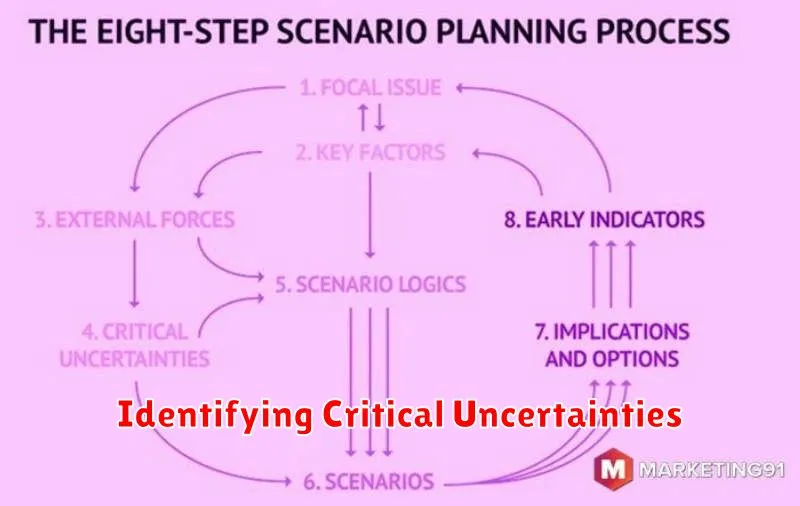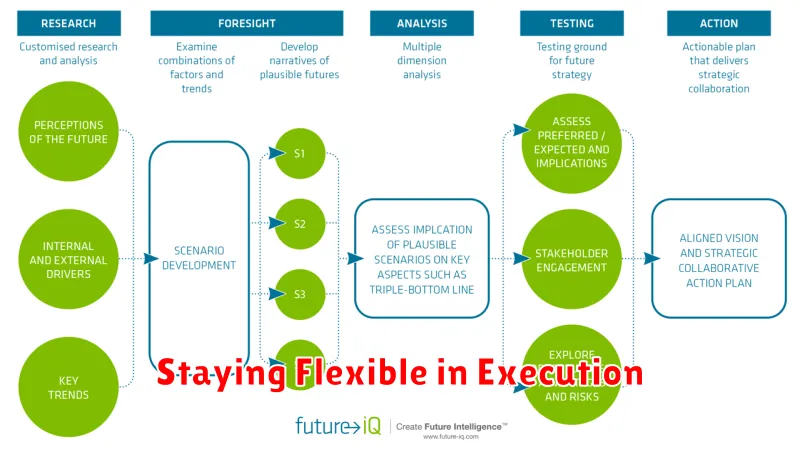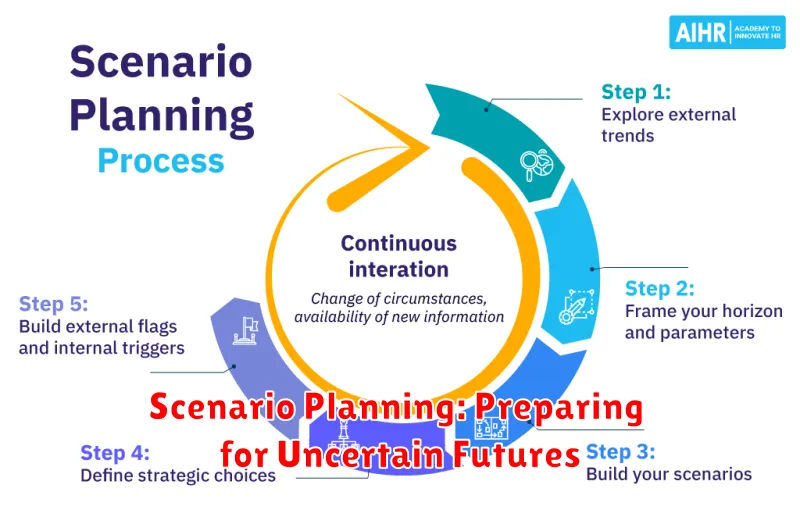In today’s rapidly evolving world, uncertainty reigns supreme. Businesses and organizations face a constant barrage of disruptive forces, from technological advancements and shifting market dynamics to geopolitical instability and climate change. Scenario planning offers a powerful framework for navigating this complex landscape. By developing a range of plausible future scenarios, organizations can better anticipate potential challenges and opportunities, develop proactive strategies, and build resilience in the face of unpredictable events. Strategic foresight, enabled by scenario planning, is no longer a luxury but a necessity for survival and success in the 21st century. This article explores the core principles of scenario planning, its practical applications, and the benefits it offers for organizations seeking to prepare for uncertain futures.
Scenario planning goes beyond traditional forecasting methods, which often rely on extrapolating past trends. Instead, it encourages organizations to think outside the box and imagine a variety of possible futures. By considering a range of alternative scenarios, organizations can challenge their assumptions, identify blind spots, and develop more robust and flexible strategies. This process allows decision-makers to move beyond reacting to events and instead proactively shape their future. This article will delve into the methodologies used in scenario planning, providing practical guidance on how to construct compelling narratives and translate them into actionable strategic decisions that will better equip your organization for the uncertainties that lie ahead.
What Is Scenario Planning?
Scenario planning is a structured process for exploring and preparing for multiple potential futures. Unlike forecasting, which aims to predict a single most likely outcome, scenario planning acknowledges the inherent uncertainty of the future and develops a range of plausible possibilities.
It involves identifying key uncertainties and drivers of change that could significantly impact an organization or system. By exploring different combinations of these factors, organizations can develop distinct scenarios, each representing a different future world.
These scenarios are narratives, not predictions, that describe how the future might unfold. They are used to challenge assumptions, stimulate strategic thinking, and develop robust strategies that can thrive in a range of possible futures.
Why It Matters for Business Resilience
In today’s volatile and unpredictable business environment, resilience is no longer a luxury, but a necessity. Scenario planning plays a crucial role in fostering this resilience by enabling organizations to anticipate and prepare for a range of potential futures.
By exploring multiple plausible scenarios, businesses can identify vulnerabilities and opportunities that might otherwise be overlooked. This proactive approach allows for the development of robust strategies that can withstand disruptions and capitalize on emerging trends.
Scenario planning contributes to stronger risk management by moving beyond traditional forecasting methods that often rely on historical data. It encourages organizations to consider a wider spectrum of possibilities, fostering a more agile and adaptable posture in the face of uncertainty.
Ultimately, scenario planning empowers businesses to make more informed decisions, enhancing their ability to navigate complexity and thrive in a constantly evolving landscape. It provides the foresight and flexibility essential for long-term success in an uncertain world.
Step-by-Step Scenario Planning Process
Scenario planning involves a structured approach to anticipating potential futures. The process begins with defining the focal issue. What critical uncertainty needs to be addressed?
Next, key drivers influencing the issue are identified and analyzed. These drivers are the forces shaping the future. Rank these drivers by importance and uncertainty.
From these drivers, develop distinct scenarios, each representing a plausible future. These scenarios are narratives, not predictions. Finally, consider the implications of each scenario for your organization and develop strategies to adapt and thrive in each potential future.
Identifying Critical Uncertainties

A crucial step in scenario planning is identifying the critical uncertainties that will significantly impact the future. These are the factors with high impact and high uncertainty surrounding their outcomes. Focusing on these key uncertainties helps to define the range of possible futures and avoid getting bogged down in less important details.
Begin by brainstorming a wide range of potential uncertainties. Consider factors like technological advancements, regulatory changes, economic shifts, and social trends. Then, evaluate each uncertainty based on its potential impact on your organization and the level of uncertainty surrounding its development. A simple impact/uncertainty matrix can be a useful tool in this process.
Prioritize the uncertainties with the highest impact and highest uncertainty. These are your critical uncertainties that will form the basis for developing distinct and plausible scenarios.
Mapping Best and Worst Cases
After identifying key uncertainties and developing distinct scenarios, the next crucial step is mapping the best and worst-case outcomes within each scenario. This involves analyzing the potential positive and negative impacts of the identified uncertainties on your organization’s objectives.
For each scenario, consider the most favorable combination of uncertain factors. This constitutes the best-case scenario. What opportunities emerge? What is the potential upside? Conversely, analyze the least favorable combination of factors, representing the worst-case scenario. What risks materialize? What is the potential downside?
This mapping exercise helps establish boundaries for potential outcomes and facilitates a more comprehensive understanding of the risks and opportunities present in each scenario.
Involving Leadership and Teams
Leadership plays a crucial role in successful scenario planning. Leaders must champion the process, dedicate necessary resources, and foster a culture open to exploring uncertainties.
Building cross-functional teams is essential. Diverse perspectives from various departments ensure a holistic view of potential future impacts and a wider range of potential responses. This collaborative approach fosters buy-in and shared ownership of the resulting plans.
Teams should be empowered to challenge assumptions and think creatively about potential disruptions. Open communication and constructive debate are vital for generating robust and actionable scenarios.
Integrating Scenarios into Strategy
Integrating scenarios into strategic planning moves beyond simply acknowledging uncertainty. It requires actively using the insights gained from scenario development to shape strategic choices. This involves evaluating the robustness of strategies across different scenarios, identifying vulnerabilities and potential opportunities.
Instead of focusing on a single “most likely” future, organizations should develop strategies that are flexible and adaptable. This might involve building in contingency plans, diversifying investments, or creating options that can be exercised depending on how the future unfolds. The goal is to develop a strategic approach that can thrive in a range of plausible futures.
Tools and Templates for Planning
Several tools and templates can assist in the scenario planning process. Using these resources can streamline the development of plausible futures and effective responses.
Scenario matrices are helpful for visualizing key uncertainties and their potential combinations. These matrices typically use two key uncertainties as axes, creating a quadrant for each possible scenario.
SWOT analysis is another useful tool for assessing internal strengths and weaknesses, as well as external opportunities and threats, within each scenario. This helps in identifying robust strategies.
Templates for scenario narratives can provide a structured approach to describing each future scenario in detail, including potential impacts on the organization.
Real Examples from Leading Brands
Examining how established companies utilize scenario planning provides valuable insights. Shell, for instance, famously used scenario planning to anticipate the 1970s oil crisis, allowing them to adapt more effectively than competitors. This proactive approach solidified their position in the energy market.
Another example is Nike. They employ scenario planning to address potential disruptions to their supply chain, considering factors like geopolitical instability and natural disasters. This preparedness allows them to maintain operational continuity and mitigate potential losses.
Google utilizes scenario planning to explore potential futures of the internet and technological advancements. This forward-thinking approach informs their research and development efforts, enabling them to remain at the forefront of innovation.
Staying Flexible in Execution

Scenario planning isn’t a one-time exercise. The true value lies in adapting to changing circumstances. Flexibility in execution is paramount. As the future unfolds, constantly monitor the leading indicators identified during the scenario development process.
Regularly review your chosen strategies and be prepared to pivot if necessary. This may involve adjusting resource allocation, revisiting partnerships, or even adopting elements of alternative scenarios. Maintain open communication throughout the organization to ensure everyone understands the evolving situation and their role in responding effectively.

